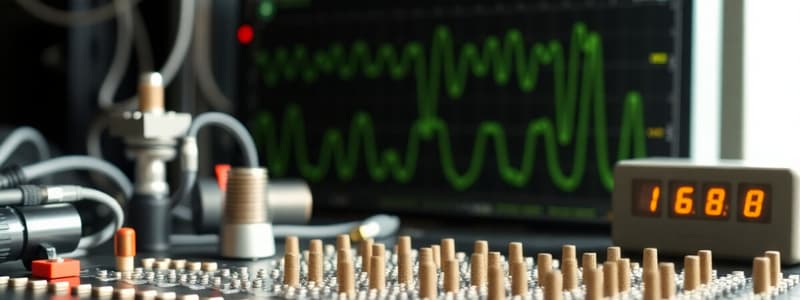Podcast
Questions and Answers
What is emphasized as the backbone for innovation and collaboration in electronics communication?
What is emphasized as the backbone for innovation and collaboration in electronics communication?
- Technical specifications
- Human communication (correct)
- Hardware development
- Software programming
What is one of the primary objectives of this module on communication systems?
What is one of the primary objectives of this module on communication systems?
- To create advanced robotics
- To develop software for electronics
- To understand communication systems (correct)
- To design consumer electronics
Which of the following signal types is characterized as continuous?
Which of the following signal types is characterized as continuous?
- Digital signals
- Periodic signals (correct)
- Aperiodic signals
- Discrete signals
What aspect of modulation techniques is primarily explained in the objectives?
What aspect of modulation techniques is primarily explained in the objectives?
Which type of transmission media is specifically mentioned as being guided?
Which type of transmission media is specifically mentioned as being guided?
What is a key property of signals that can be identified and differentiated?
What is a key property of signals that can be identified and differentiated?
Which of the following best represents a characteristic of a discrete signal?
Which of the following best represents a characteristic of a discrete signal?
What is the importance of understanding the classifications of communication systems?
What is the importance of understanding the classifications of communication systems?
What does amplitude modulation (AM) primarily regulate?
What does amplitude modulation (AM) primarily regulate?
Which of the following is an advantage of digital signals?
Which of the following is an advantage of digital signals?
Which statement is a disadvantage of digital signals?
Which statement is a disadvantage of digital signals?
What is a key feature of digital circuits in terms of data representation?
What is a key feature of digital circuits in terms of data representation?
Which of the following statements regarding analog signals is true?
Which of the following statements regarding analog signals is true?
What characteristic makes digital signal processing more flexible?
What characteristic makes digital signal processing more flexible?
Which of the following is a disadvantage of analog communication systems?
Which of the following is a disadvantage of analog communication systems?
In digital electronics, what is primarily used to ensure predictable operation?
In digital electronics, what is primarily used to ensure predictable operation?
What does internal noise result from?
What does internal noise result from?
Which of the following describes a transceiver?
Which of the following describes a transceiver?
Which type of communication allows simultaneous two-way transmission?
Which type of communication allows simultaneous two-way transmission?
What is the main function of a receiver?
What is the main function of a receiver?
Which of the following is NOT a source of external noise?
Which of the following is NOT a source of external noise?
What is an example of simplex communication?
What is an example of simplex communication?
What primarily distinguishes half duplex communication from full duplex?
What primarily distinguishes half duplex communication from full duplex?
Which component is NOT typically found in a receiver?
Which component is NOT typically found in a receiver?
Which statement about signals in the time domain is correct?
Which statement about signals in the time domain is correct?
What does Amplitude Modulation (AM) encode in a carrier wave?
What does Amplitude Modulation (AM) encode in a carrier wave?
What is free-space path loss most directly related to in satellite communications?
What is free-space path loss most directly related to in satellite communications?
Which of the following best describes the significance of Signal-to-Noise Ratio (SNR)?
Which of the following best describes the significance of Signal-to-Noise Ratio (SNR)?
What does bandwidth determine in satellite communications?
What does bandwidth determine in satellite communications?
Which of the following factors is affected by phase noise in satellite communications?
Which of the following factors is affected by phase noise in satellite communications?
Which modulation technique represents information by varying the frequency of a carrier wave?
Which modulation technique represents information by varying the frequency of a carrier wave?
How can the required bandwidth for a signal be estimated?
How can the required bandwidth for a signal be estimated?
What effect does phase noise have on satellite communications?
What effect does phase noise have on satellite communications?
Which is a key characteristic of Amplitude Modulation (AM)?
Which is a key characteristic of Amplitude Modulation (AM)?
What is one of the primary purposes of modulation in communication systems?
What is one of the primary purposes of modulation in communication systems?
What type of modulation technique encodes information by varying phase?
What type of modulation technique encodes information by varying phase?
Which modulation technique is primarily used in AM radio broadcasting?
Which modulation technique is primarily used in AM radio broadcasting?
In what way does phase noise commonly affect a satellite transponder's signal?
In what way does phase noise commonly affect a satellite transponder's signal?
Which of the following is NOT a type of modulation technique?
Which of the following is NOT a type of modulation technique?
What makes AM particularly susceptible when used in communication systems?
What makes AM particularly susceptible when used in communication systems?
Flashcards are hidden until you start studying
Study Notes
Introduction to Communication Systems
- Electronic communication is essential in today's world due to technological advancement.
- It plays a key role in innovation, collaboration, and implementation of electronic systems and solutions.
- It has transformed how we interact with technology and each other.
Signal Types and Properties
- Signals are the foundation of communication systems.
- They are represented in time and frequency domains.
- Time domain shows how signals change over time.
- Frequency domain shows frequency content and their respective amplitudes.
Modulation Techniques
- Modulation adapts signals for efficient transmission.
- It involves varying a carrier signal's properties (amplitude, frequency, or phase) to encode information.
- Important Techniques: Amplitude Modulation (AM), Frequency Modulation (FM) and Phase Modulation (PM)
- AM encodes information in the amplitude of the carrier wave.
- FM encodes information in the frequency of the carrier wave.
- PM encodes information in the phase of the carrier wave.
Transmission Media
- Signals propagate through various media.
- Media can affect signal strength and quality.
- A key factor in transmission: Free-space path loss (attenuation of signal power over distance).
Signal-to-Noise Ratio (SNR)
- SNR measures the ratio of desired signal to background noise.
- It is often expressed in decibels (dB).
- A higher SNR indicates a clearer signal.
- Maintaining a high SNR ensures reliable data transmission.
Bandwidth
- Bandwidth is the range of frequencies a signal is transmitted or received.
- It determines data rate and channel capacity.
- Bandwidth can be estimated using Nyquist’s or Shannon’s theorems.
Phase Noise
- Phase noise causes random phase fluctuations in a signal.
- It affects satellite communications systems requiring a stable reference oscillator for signal generation and synchronization.
- Phase noise can degrade communication performance through errors in signal demodulation.
Electronic Communication Classification
- Electronic communication is classified based on transmission type and signal type
- Transmission types: Simplex, Full Duplex, Half Duplex
- Simplex: One-way communication (e.g., radio, TV broadcasting)
- Duplex: Two-way communication
- Full duplex: Simultaneous two-way communication (e.g., telephone)
- Half duplex: One-way communication at a time (e.g., police radio)
- Signal types: Analog and Digital
- Analog: Continuously varying signals (e.g., audio, video)
- Digital: Discrete signals represented by 0s and 1s (e.g., computer data)
Advantages of Analog Signals
- Easier to process.
- Well-suited for audio and video transmission.
- Higher density.
- Provides more accurate representation of physical quantities (e.g., sound, light, temperature).
- Analog systems are less sensitive to electrical tolerances.
Disadvantages of Analog Signals
- Data transmission over long distances can lead to undesirable signal disturbances.
- Prone to signal loss.
- Susceptible to noise and distortion.
Advantages of Digital Signals
- Less noise, distortion, and interference.
- Digital signal processing is more flexible, accurate, and secure.
- Digital signals can be readily stored on magnetic or optical media.
- Digital signals can be transmitted over long distances.
Disadvantages of Digital Signals
- Requires higher bandwidth for digital communication.
- Higher power dissipation compared to analog signal processing.
- Digital systems and processing are typically more complex.
Definition of Modulation
- Modulation is the process of varying carrier signal properties (amplitude, frequency, or phase) to encode information for transmission.
Purpose of Modulation
- Enables efficient long-distance signal transmission.
- Optimizes bandwidth utilization.
- Minimizes interference from noise.
Types of Modulation Techniques
- Common modulation techniques include AM, FM, and PM.
- Each has unique characteristics and applications.
Amplitude Modulation (AM)
- Encodes information in the amplitude of a carrier wave.
- Simple to implement and received by standard radio receivers.
- More susceptible to noise and interference compared to other methods.
Applications of AM
- AM radio broadcasting.
- Aviation communication.
- Two-way radio systems (voice and audio signals).
Studying That Suits You
Use AI to generate personalized quizzes and flashcards to suit your learning preferences.




